The Environment Protection Authority
VerifiedAdded on 2022/09/06
|10
|1860
|22
AI Summary
Contribute Materials
Your contribution can guide someone’s learning journey. Share your
documents today.
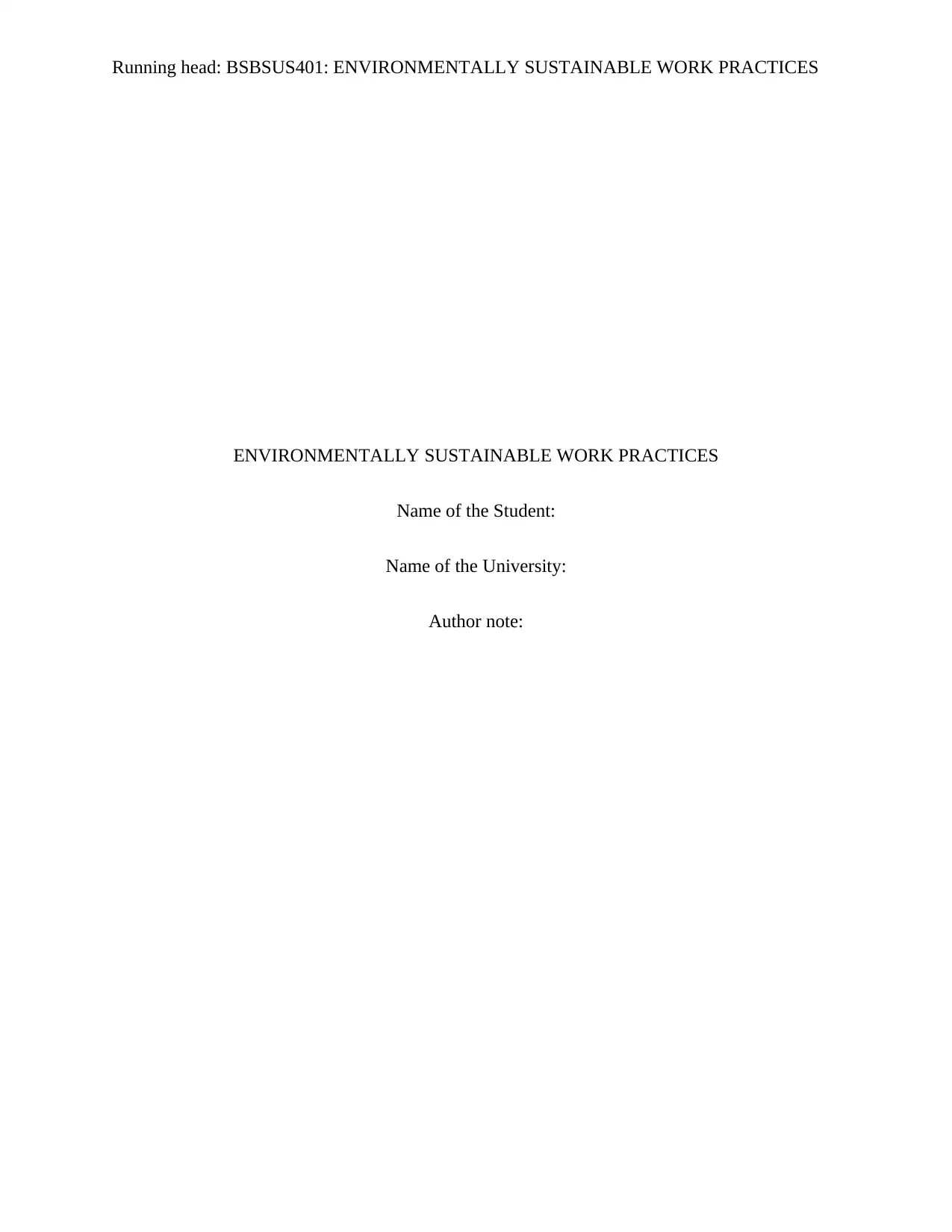
Running head: BSBSUS401: ENVIRONMENTALLY SUSTAINABLE WORK PRACTICES
ENVIRONMENTALLY SUSTAINABLE WORK PRACTICES
Name of the Student:
Name of the University:
Author note:
ENVIRONMENTALLY SUSTAINABLE WORK PRACTICES
Name of the Student:
Name of the University:
Author note:
Secure Best Marks with AI Grader
Need help grading? Try our AI Grader for instant feedback on your assignments.
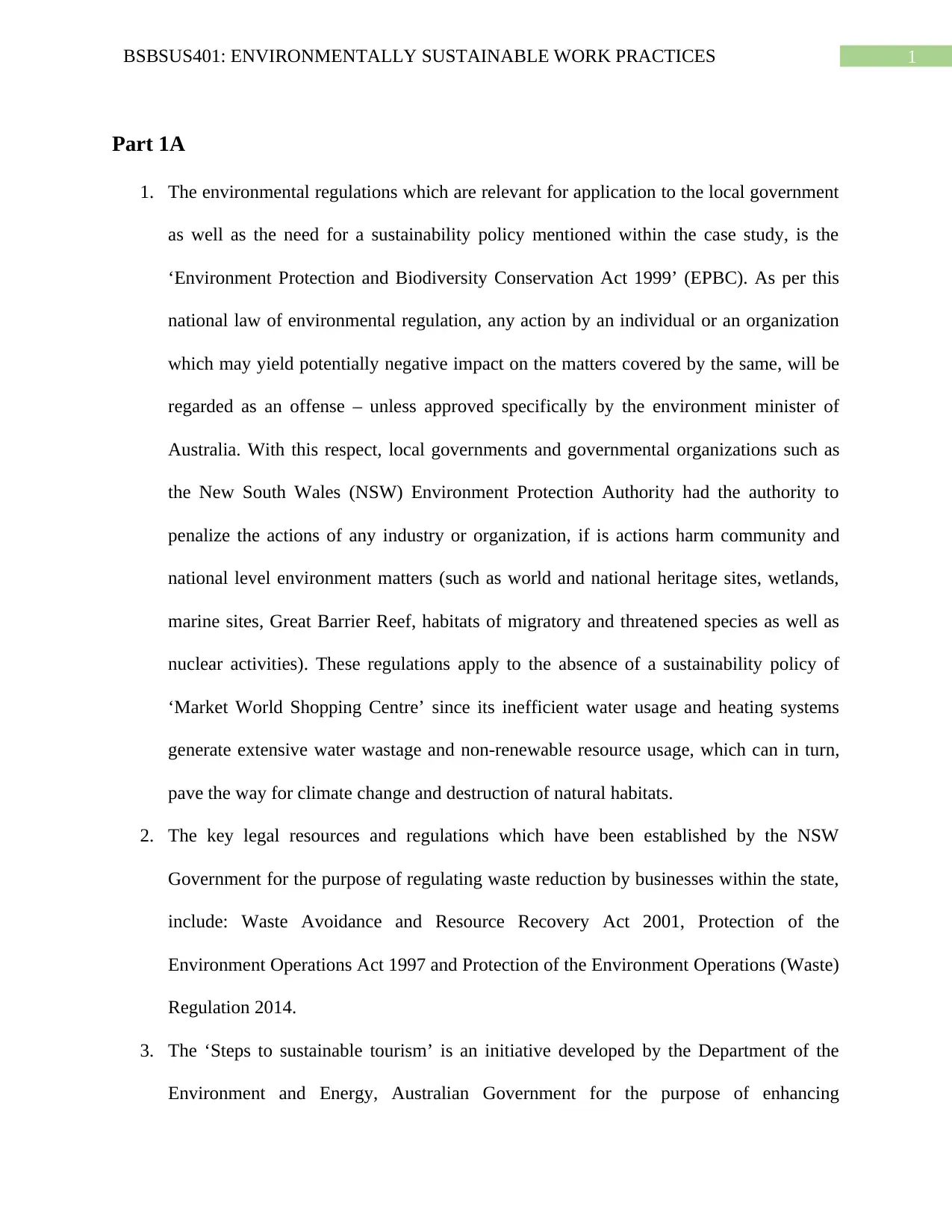
1BSBSUS401: ENVIRONMENTALLY SUSTAINABLE WORK PRACTICES
Part 1A
1. The environmental regulations which are relevant for application to the local government
as well as the need for a sustainability policy mentioned within the case study, is the
‘Environment Protection and Biodiversity Conservation Act 1999’ (EPBC). As per this
national law of environmental regulation, any action by an individual or an organization
which may yield potentially negative impact on the matters covered by the same, will be
regarded as an offense – unless approved specifically by the environment minister of
Australia. With this respect, local governments and governmental organizations such as
the New South Wales (NSW) Environment Protection Authority had the authority to
penalize the actions of any industry or organization, if is actions harm community and
national level environment matters (such as world and national heritage sites, wetlands,
marine sites, Great Barrier Reef, habitats of migratory and threatened species as well as
nuclear activities). These regulations apply to the absence of a sustainability policy of
‘Market World Shopping Centre’ since its inefficient water usage and heating systems
generate extensive water wastage and non-renewable resource usage, which can in turn,
pave the way for climate change and destruction of natural habitats.
2. The key legal resources and regulations which have been established by the NSW
Government for the purpose of regulating waste reduction by businesses within the state,
include: Waste Avoidance and Resource Recovery Act 2001, Protection of the
Environment Operations Act 1997 and Protection of the Environment Operations (Waste)
Regulation 2014.
3. The ‘Steps to sustainable tourism’ is an initiative developed by the Department of the
Environment and Energy, Australian Government for the purpose of enhancing
Part 1A
1. The environmental regulations which are relevant for application to the local government
as well as the need for a sustainability policy mentioned within the case study, is the
‘Environment Protection and Biodiversity Conservation Act 1999’ (EPBC). As per this
national law of environmental regulation, any action by an individual or an organization
which may yield potentially negative impact on the matters covered by the same, will be
regarded as an offense – unless approved specifically by the environment minister of
Australia. With this respect, local governments and governmental organizations such as
the New South Wales (NSW) Environment Protection Authority had the authority to
penalize the actions of any industry or organization, if is actions harm community and
national level environment matters (such as world and national heritage sites, wetlands,
marine sites, Great Barrier Reef, habitats of migratory and threatened species as well as
nuclear activities). These regulations apply to the absence of a sustainability policy of
‘Market World Shopping Centre’ since its inefficient water usage and heating systems
generate extensive water wastage and non-renewable resource usage, which can in turn,
pave the way for climate change and destruction of natural habitats.
2. The key legal resources and regulations which have been established by the NSW
Government for the purpose of regulating waste reduction by businesses within the state,
include: Waste Avoidance and Resource Recovery Act 2001, Protection of the
Environment Operations Act 1997 and Protection of the Environment Operations (Waste)
Regulation 2014.
3. The ‘Steps to sustainable tourism’ is an initiative developed by the Department of the
Environment and Energy, Australian Government for the purpose of enhancing

2BSBSUS401: ENVIRONMENTALLY SUSTAINABLE WORK PRACTICES
sustainability within the tourism and hospitality sector. Hotels and organizations dealing
with tourism and hospitality in Australia can encourage sustainable tourism by using
relevant resources like environmental audit reports, sustainable business plans, and
development of sustainable infrastructure and process analysis of unsustainable practices
as developed by this initiative.
Part 1B
Templates
Water Meter Meter Reading: 0.2 gallons/cubic feet
Quarterly
Period
Water
Use
kL/period
Aver Daily
Use
Cost of
Water
per kL
Sewage
Disposal
Costs
Connection
Fees
Target Variance
January to
March
22500
gallons
250
gallons
$ 3.10 $ 50
/tonne of
waste
$ 30/ day 100
gallons/day
150 gallons
excess
April to
June
18000
gallons
200
gallons
$ 3.10 $ 50
/tonne of
waste
$ 30/ day 100
gallons/day
100 gallons
excess
July to
September
21000
gallons
233
gallons
$ 3.10 $ 50
/tonne of
waste
$ 30/ day 100
gallons/day
133 gallons
excess
October to
December
24000
gallons
266
gallons
$ 3.10 $ 50
/tonne of
waste
$ 30/ day 100
gallons/day
166 gallons
excess
Water Appliances (determine usage)
Location Item Type Water flow
(L/min)
Amount/
Type
Bathroom
Shower Daily use 300L/min Daily use
Laundry
Room
Washin
g
Machin
e
Daily use 400L/min Daily use
sustainability within the tourism and hospitality sector. Hotels and organizations dealing
with tourism and hospitality in Australia can encourage sustainable tourism by using
relevant resources like environmental audit reports, sustainable business plans, and
development of sustainable infrastructure and process analysis of unsustainable practices
as developed by this initiative.
Part 1B
Templates
Water Meter Meter Reading: 0.2 gallons/cubic feet
Quarterly
Period
Water
Use
kL/period
Aver Daily
Use
Cost of
Water
per kL
Sewage
Disposal
Costs
Connection
Fees
Target Variance
January to
March
22500
gallons
250
gallons
$ 3.10 $ 50
/tonne of
waste
$ 30/ day 100
gallons/day
150 gallons
excess
April to
June
18000
gallons
200
gallons
$ 3.10 $ 50
/tonne of
waste
$ 30/ day 100
gallons/day
100 gallons
excess
July to
September
21000
gallons
233
gallons
$ 3.10 $ 50
/tonne of
waste
$ 30/ day 100
gallons/day
133 gallons
excess
October to
December
24000
gallons
266
gallons
$ 3.10 $ 50
/tonne of
waste
$ 30/ day 100
gallons/day
166 gallons
excess
Water Appliances (determine usage)
Location Item Type Water flow
(L/min)
Amount/
Type
Bathroom
Shower Daily use 300L/min Daily use
Laundry
Room
Washin
g
Machin
e
Daily use 400L/min Daily use
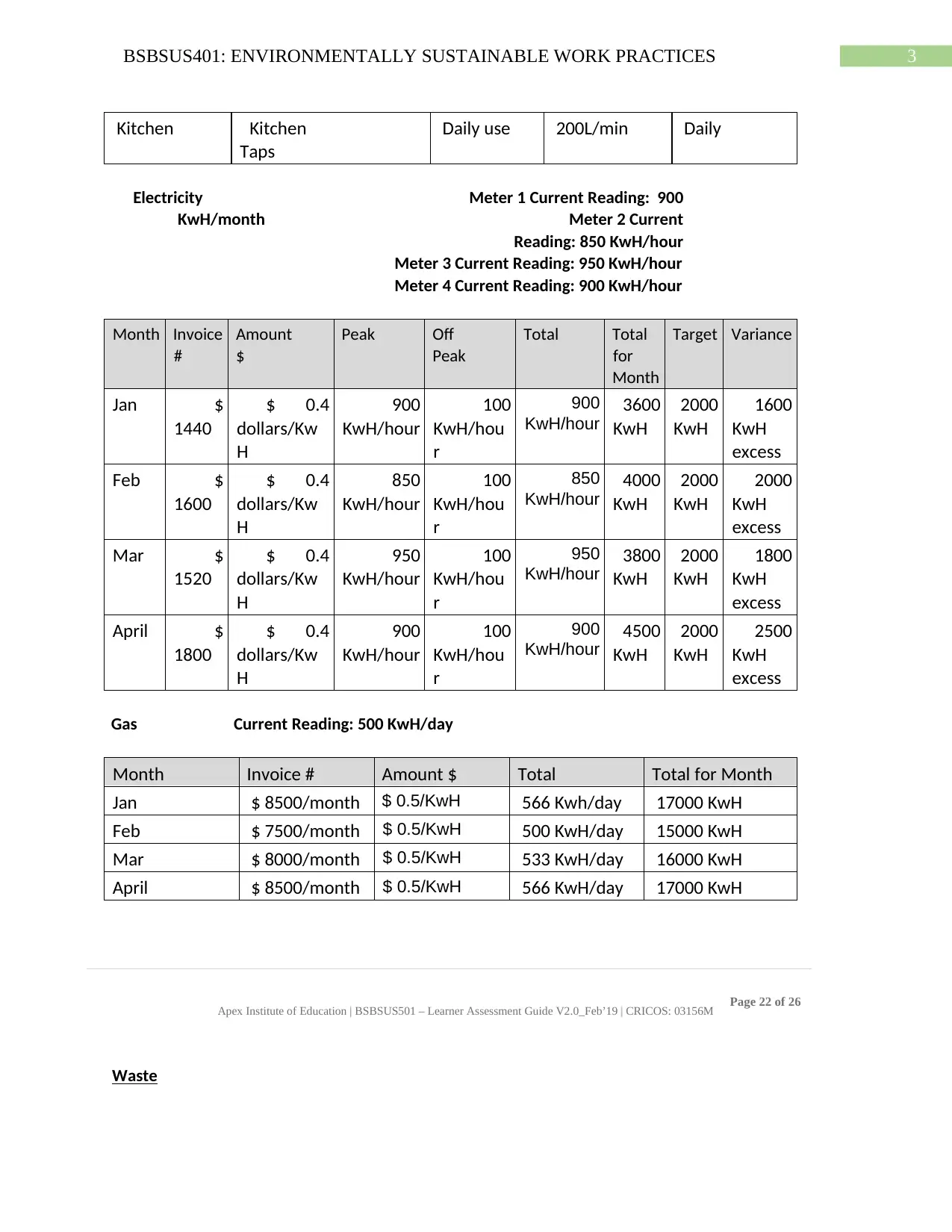
3BSBSUS401: ENVIRONMENTALLY SUSTAINABLE WORK PRACTICES
Kitchen Kitchen
Taps
Daily use 200L/min Daily
Electricity Meter 1 Current Reading: 900
KwH/month Meter 2 Current
Reading: 850 KwH/hour
Meter 3 Current Reading: 950 KwH/hour
Meter 4 Current Reading: 900 KwH/hour
Month Invoice
#
Amount
$
Peak Off
Peak
Total Total
for
Month
Target Variance
Jan $
1440
$ 0.4
dollars/Kw
H
900
KwH/hour
100
KwH/hou
r
900
KwH/hour
3600
KwH
2000
KwH
1600
KwH
excess
Feb $
1600
$ 0.4
dollars/Kw
H
850
KwH/hour
100
KwH/hou
r
850
KwH/hour
4000
KwH
2000
KwH
2000
KwH
excess
Mar $
1520
$ 0.4
dollars/Kw
H
950
KwH/hour
100
KwH/hou
r
950
KwH/hour
3800
KwH
2000
KwH
1800
KwH
excess
April $
1800
$ 0.4
dollars/Kw
H
900
KwH/hour
100
KwH/hou
r
900
KwH/hour
4500
KwH
2000
KwH
2500
KwH
excess
Gas Current Reading: 500 KwH/day
Month Invoice # Amount $ Total Total for Month
Jan $ 8500/month $ 0.5/KwH 566 Kwh/day 17000 KwH
Feb $ 7500/month $ 0.5/KwH 500 KwH/day 15000 KwH
Mar $ 8000/month $ 0.5/KwH 533 KwH/day 16000 KwH
April $ 8500/month $ 0.5/KwH 566 KwH/day 17000 KwH
Apex Institute of Education | BSBSUS501 – Learner Assessment Guide V2.0_Feb’19 | CRICOS: 03156M Page 22 of 26
Waste
Kitchen Kitchen
Taps
Daily use 200L/min Daily
Electricity Meter 1 Current Reading: 900
KwH/month Meter 2 Current
Reading: 850 KwH/hour
Meter 3 Current Reading: 950 KwH/hour
Meter 4 Current Reading: 900 KwH/hour
Month Invoice
#
Amount
$
Peak Off
Peak
Total Total
for
Month
Target Variance
Jan $
1440
$ 0.4
dollars/Kw
H
900
KwH/hour
100
KwH/hou
r
900
KwH/hour
3600
KwH
2000
KwH
1600
KwH
excess
Feb $
1600
$ 0.4
dollars/Kw
H
850
KwH/hour
100
KwH/hou
r
850
KwH/hour
4000
KwH
2000
KwH
2000
KwH
excess
Mar $
1520
$ 0.4
dollars/Kw
H
950
KwH/hour
100
KwH/hou
r
950
KwH/hour
3800
KwH
2000
KwH
1800
KwH
excess
April $
1800
$ 0.4
dollars/Kw
H
900
KwH/hour
100
KwH/hou
r
900
KwH/hour
4500
KwH
2000
KwH
2500
KwH
excess
Gas Current Reading: 500 KwH/day
Month Invoice # Amount $ Total Total for Month
Jan $ 8500/month $ 0.5/KwH 566 Kwh/day 17000 KwH
Feb $ 7500/month $ 0.5/KwH 500 KwH/day 15000 KwH
Mar $ 8000/month $ 0.5/KwH 533 KwH/day 16000 KwH
April $ 8500/month $ 0.5/KwH 566 KwH/day 17000 KwH
Apex Institute of Education | BSBSUS501 – Learner Assessment Guide V2.0_Feb’19 | CRICOS: 03156M Page 22 of 26
Waste
Secure Best Marks with AI Grader
Need help grading? Try our AI Grader for instant feedback on your assignments.
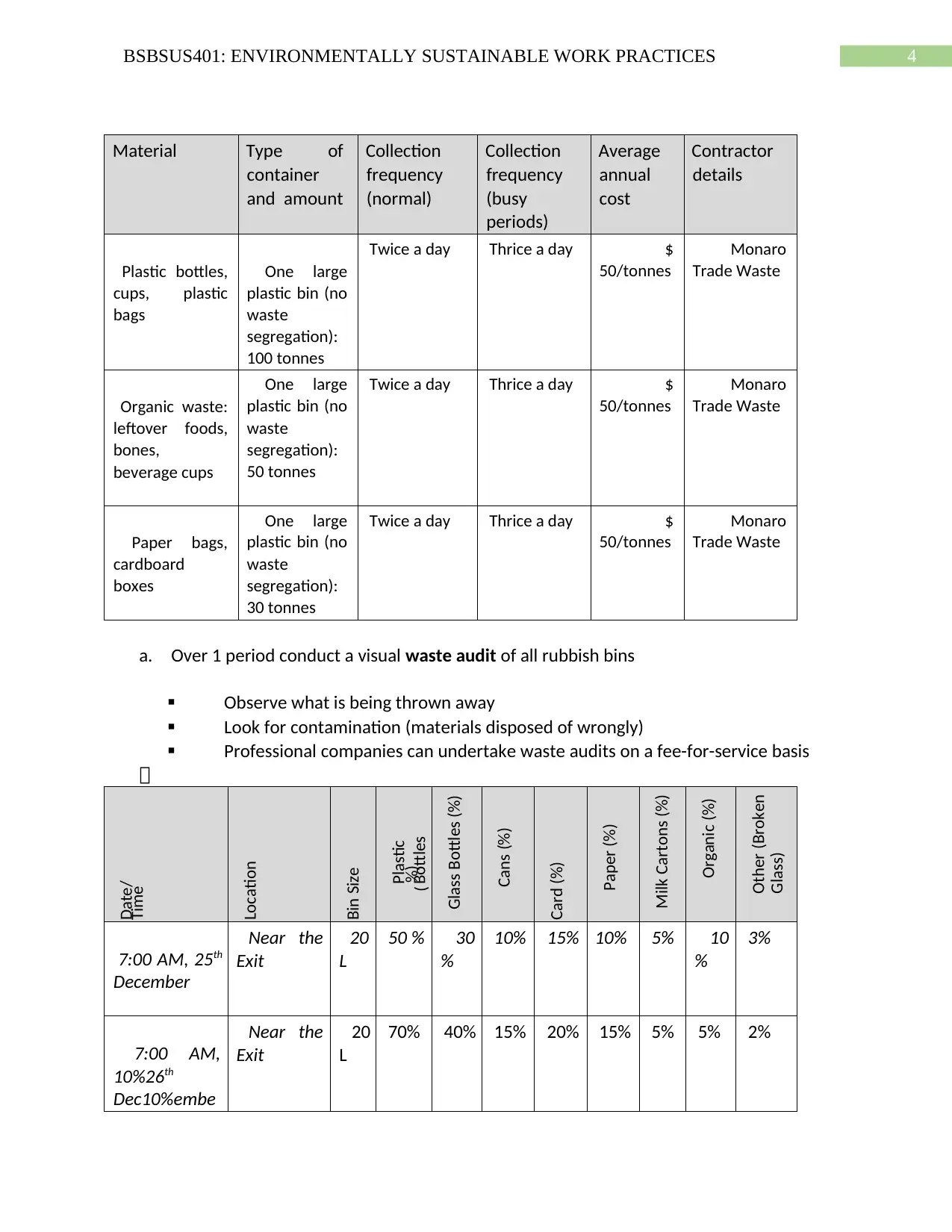
4BSBSUS401: ENVIRONMENTALLY SUSTAINABLE WORK PRACTICES
Material Type of
container
and amount
Collection
frequency
(normal)
Collection
frequency
(busy
periods)
Average
annual
cost
Contractor
details
Plastic bottles,
cups, plastic
bags
One large
plastic bin (no
waste
segregation):
100 tonnes
Twice a day Thrice a day $
50/tonnes
Monaro
Trade Waste
Organic waste:
leftover foods,
bones,
beverage cups
One large
plastic bin (no
waste
segregation):
50 tonnes
Twice a day Thrice a day $
50/tonnes
Monaro
Trade Waste
Paper bags,
cardboard
boxes
One large
plastic bin (no
waste
segregation):
30 tonnes
Twice a day Thrice a day $
50/tonnes
Monaro
Trade Waste
a. Over 1 period conduct a visual waste audit of all rubbish bins
Observe what is being thrown away
Look for contamination (materials disposed of wrongly)
Professional companies can undertake waste audits on a fee-for-service basis
7:00 AM, 25th
December
Near the
Exit
20
L
50 % 30
%
10% 15% 10% 5% 10
%
3%
7:00 AM,
10%26th
Dec10%embe
Near the
Exit
20
L
70% 40% 15% 20% 15% 5% 5% 2%
Date/
Time
Location
Bin Size
Plastic
Bottles( %)
Glass Bottles (%)
Cans (%)
Card (%)
Paper (%)
Milk Cartons (%)
Organic (%)
Other (Broken
Glass)
Material Type of
container
and amount
Collection
frequency
(normal)
Collection
frequency
(busy
periods)
Average
annual
cost
Contractor
details
Plastic bottles,
cups, plastic
bags
One large
plastic bin (no
waste
segregation):
100 tonnes
Twice a day Thrice a day $
50/tonnes
Monaro
Trade Waste
Organic waste:
leftover foods,
bones,
beverage cups
One large
plastic bin (no
waste
segregation):
50 tonnes
Twice a day Thrice a day $
50/tonnes
Monaro
Trade Waste
Paper bags,
cardboard
boxes
One large
plastic bin (no
waste
segregation):
30 tonnes
Twice a day Thrice a day $
50/tonnes
Monaro
Trade Waste
a. Over 1 period conduct a visual waste audit of all rubbish bins
Observe what is being thrown away
Look for contamination (materials disposed of wrongly)
Professional companies can undertake waste audits on a fee-for-service basis
7:00 AM, 25th
December
Near the
Exit
20
L
50 % 30
%
10% 15% 10% 5% 10
%
3%
7:00 AM,
10%26th
Dec10%embe
Near the
Exit
20
L
70% 40% 15% 20% 15% 5% 5% 2%
Date/
Time
Location
Bin Size
Plastic
Bottles( %)
Glass Bottles (%)
Cans (%)
Card (%)
Paper (%)
Milk Cartons (%)
Organic (%)
Other (Broken
Glass)
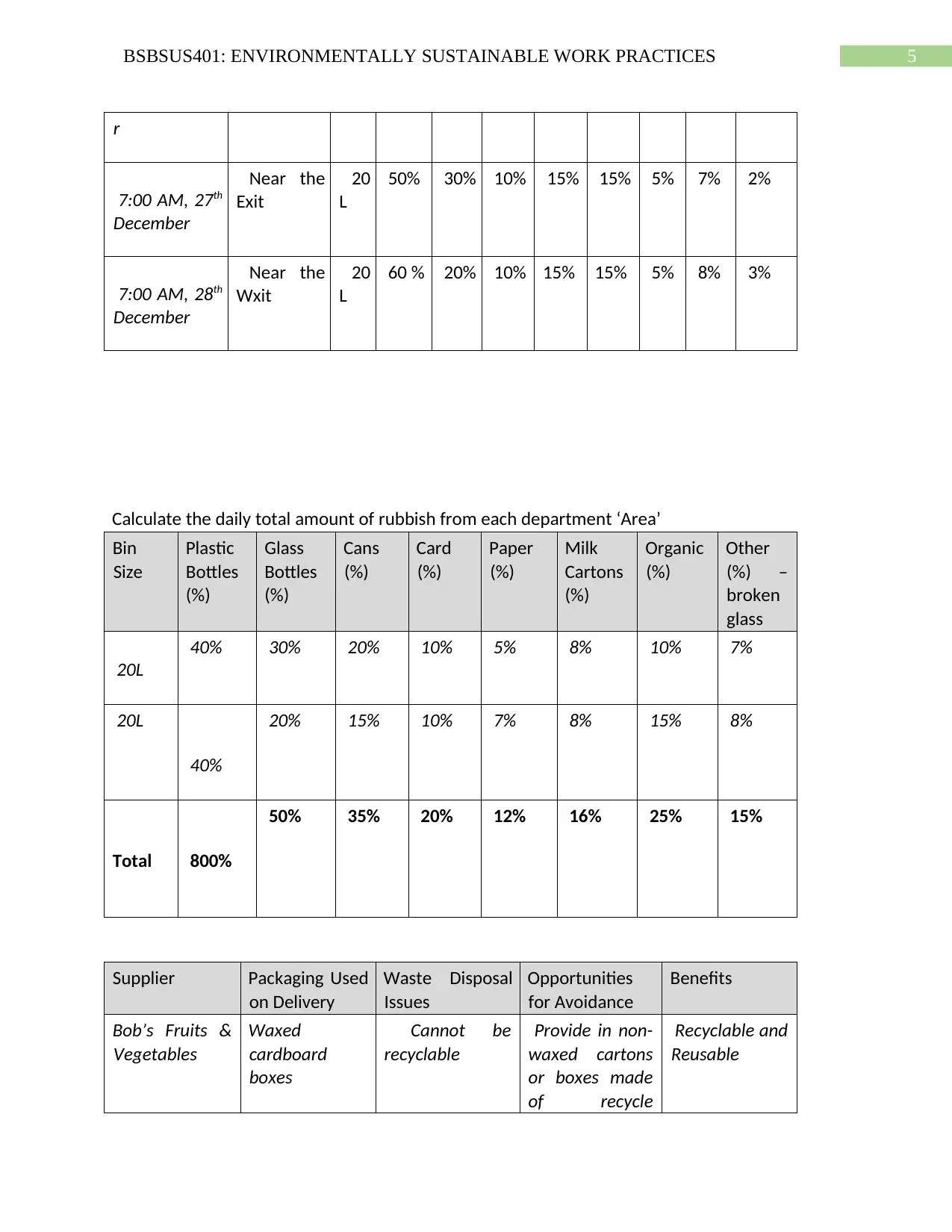
5BSBSUS401: ENVIRONMENTALLY SUSTAINABLE WORK PRACTICES
r
7:00 AM, 27th
December
Near the
Exit
20
L
50% 30% 10% 15% 15% 5% 7% 2%
7:00 AM, 28th
December
Near the
Wxit
20
L
60 % 20% 10% 15% 15% 5% 8% 3%
Calculate the daily total amount of rubbish from each department ‘Area’
Bin
Size
Plastic
Bottles
(%)
Glass
Bottles
(%)
Cans
(%)
Card
(%)
Paper
(%)
Milk
Cartons
(%)
Organic
(%)
Other
(%) –
broken
glass
20L
40% 30% 20% 10% 5% 8% 10% 7%
20L
40%
20% 15% 10% 7% 8% 15% 8%
Total 800%
50% 35% 20% 12% 16% 25% 15%
Supplier Packaging Used
on Delivery
Waste Disposal
Issues
Opportunities
for Avoidance
Benefits
Bob’s Fruits &
Vegetables
Waxed
cardboard
boxes
Cannot be
recyclable
Provide in non-
waxed cartons
or boxes made
of recycle
Recyclable and
Reusable
r
7:00 AM, 27th
December
Near the
Exit
20
L
50% 30% 10% 15% 15% 5% 7% 2%
7:00 AM, 28th
December
Near the
Wxit
20
L
60 % 20% 10% 15% 15% 5% 8% 3%
Calculate the daily total amount of rubbish from each department ‘Area’
Bin
Size
Plastic
Bottles
(%)
Glass
Bottles
(%)
Cans
(%)
Card
(%)
Paper
(%)
Milk
Cartons
(%)
Organic
(%)
Other
(%) –
broken
glass
20L
40% 30% 20% 10% 5% 8% 10% 7%
20L
40%
20% 15% 10% 7% 8% 15% 8%
Total 800%
50% 35% 20% 12% 16% 25% 15%
Supplier Packaging Used
on Delivery
Waste Disposal
Issues
Opportunities
for Avoidance
Benefits
Bob’s Fruits &
Vegetables
Waxed
cardboard
boxes
Cannot be
recyclable
Provide in non-
waxed cartons
or boxes made
of recycle
Recyclable and
Reusable

6BSBSUS401: ENVIRONMENTALLY SUSTAINABLE WORK PRACTICES
cardboard
Mary’s Dairy
and Dairy
Products
Plastic
packets
Non-
biodegradable
Provide in non-
waxed tetra
packs
Recyclable and
Reusable
Adam’s Meat
Co.
Plastic packets Non-
biodegradadabl
e
Provide in non-
waxed cartons
or boxes made
of recycle
cardboard
Recyclable and
Reusable
Part 1C
1. Waste segregation practices must be conducted and waste disposal frequency must be
increased. Recyclable and reusable packaging must be used for supplier items. Current
practices do not comply with ISO 14004:2018 standards of waste management and
project life cycle assessments. Energy efficient appliances like starred products are not
used. Replacing gas with electricity during cooking can serve as a means of adhering to
energy efficient practices. There is a need to adhere to business recommendations of
adhering to ISO 14004:2018 and New South Wales (NSW) Environment Protection
Authority standards.
2. Proposed targets are: 100 gallons of water/day and 2000 KwH of electricity/month.
To: Monaro Trade Waste,
From: Market World Shopping Centre
Dear Sir/Ma’am,
cardboard
Mary’s Dairy
and Dairy
Products
Plastic
packets
Non-
biodegradable
Provide in non-
waxed tetra
packs
Recyclable and
Reusable
Adam’s Meat
Co.
Plastic packets Non-
biodegradadabl
e
Provide in non-
waxed cartons
or boxes made
of recycle
cardboard
Recyclable and
Reusable
Part 1C
1. Waste segregation practices must be conducted and waste disposal frequency must be
increased. Recyclable and reusable packaging must be used for supplier items. Current
practices do not comply with ISO 14004:2018 standards of waste management and
project life cycle assessments. Energy efficient appliances like starred products are not
used. Replacing gas with electricity during cooking can serve as a means of adhering to
energy efficient practices. There is a need to adhere to business recommendations of
adhering to ISO 14004:2018 and New South Wales (NSW) Environment Protection
Authority standards.
2. Proposed targets are: 100 gallons of water/day and 2000 KwH of electricity/month.
To: Monaro Trade Waste,
From: Market World Shopping Centre
Dear Sir/Ma’am,
Paraphrase This Document
Need a fresh take? Get an instant paraphrase of this document with our AI Paraphraser
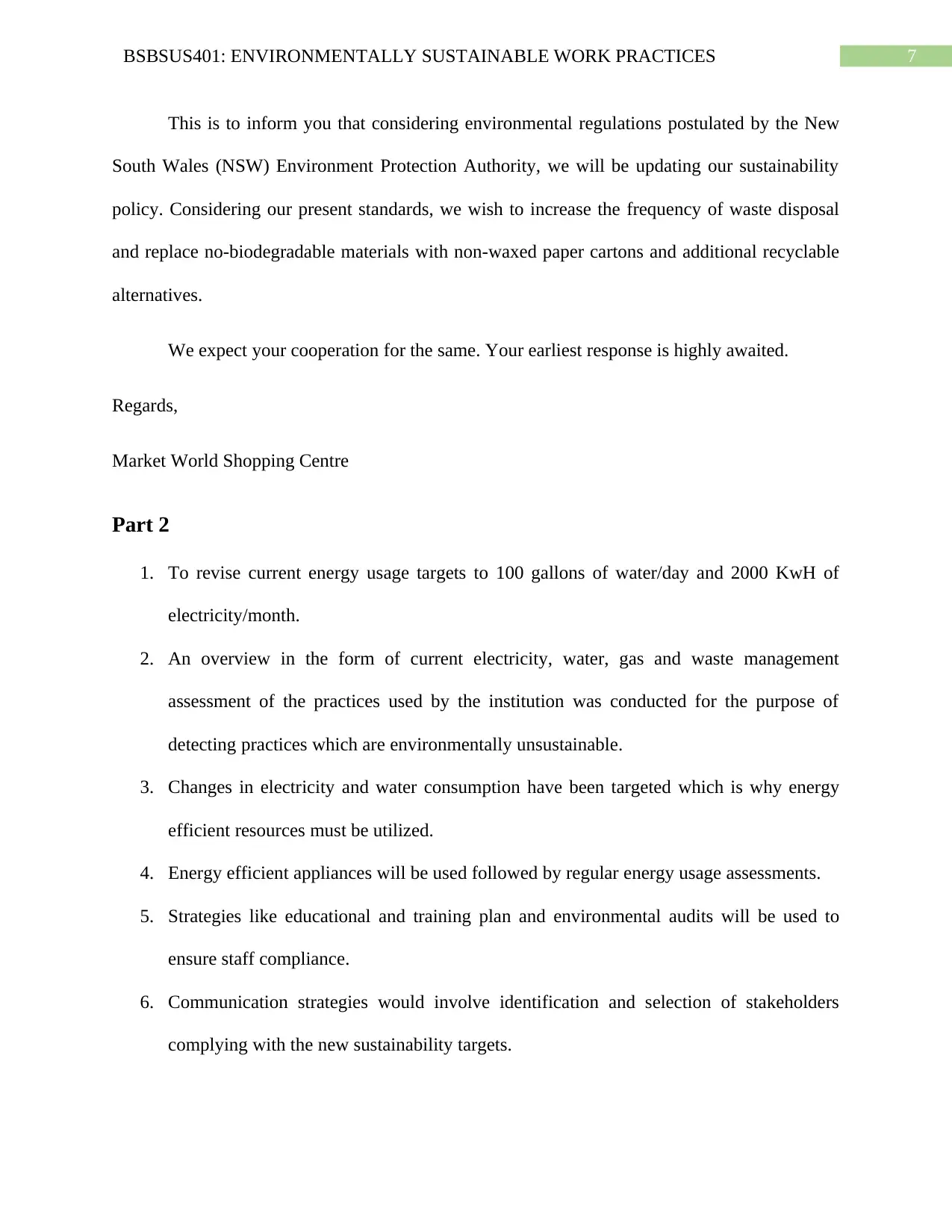
7BSBSUS401: ENVIRONMENTALLY SUSTAINABLE WORK PRACTICES
This is to inform you that considering environmental regulations postulated by the New
South Wales (NSW) Environment Protection Authority, we will be updating our sustainability
policy. Considering our present standards, we wish to increase the frequency of waste disposal
and replace no-biodegradable materials with non-waxed paper cartons and additional recyclable
alternatives.
We expect your cooperation for the same. Your earliest response is highly awaited.
Regards,
Market World Shopping Centre
Part 2
1. To revise current energy usage targets to 100 gallons of water/day and 2000 KwH of
electricity/month.
2. An overview in the form of current electricity, water, gas and waste management
assessment of the practices used by the institution was conducted for the purpose of
detecting practices which are environmentally unsustainable.
3. Changes in electricity and water consumption have been targeted which is why energy
efficient resources must be utilized.
4. Energy efficient appliances will be used followed by regular energy usage assessments.
5. Strategies like educational and training plan and environmental audits will be used to
ensure staff compliance.
6. Communication strategies would involve identification and selection of stakeholders
complying with the new sustainability targets.
This is to inform you that considering environmental regulations postulated by the New
South Wales (NSW) Environment Protection Authority, we will be updating our sustainability
policy. Considering our present standards, we wish to increase the frequency of waste disposal
and replace no-biodegradable materials with non-waxed paper cartons and additional recyclable
alternatives.
We expect your cooperation for the same. Your earliest response is highly awaited.
Regards,
Market World Shopping Centre
Part 2
1. To revise current energy usage targets to 100 gallons of water/day and 2000 KwH of
electricity/month.
2. An overview in the form of current electricity, water, gas and waste management
assessment of the practices used by the institution was conducted for the purpose of
detecting practices which are environmentally unsustainable.
3. Changes in electricity and water consumption have been targeted which is why energy
efficient resources must be utilized.
4. Energy efficient appliances will be used followed by regular energy usage assessments.
5. Strategies like educational and training plan and environmental audits will be used to
ensure staff compliance.
6. Communication strategies would involve identification and selection of stakeholders
complying with the new sustainability targets.
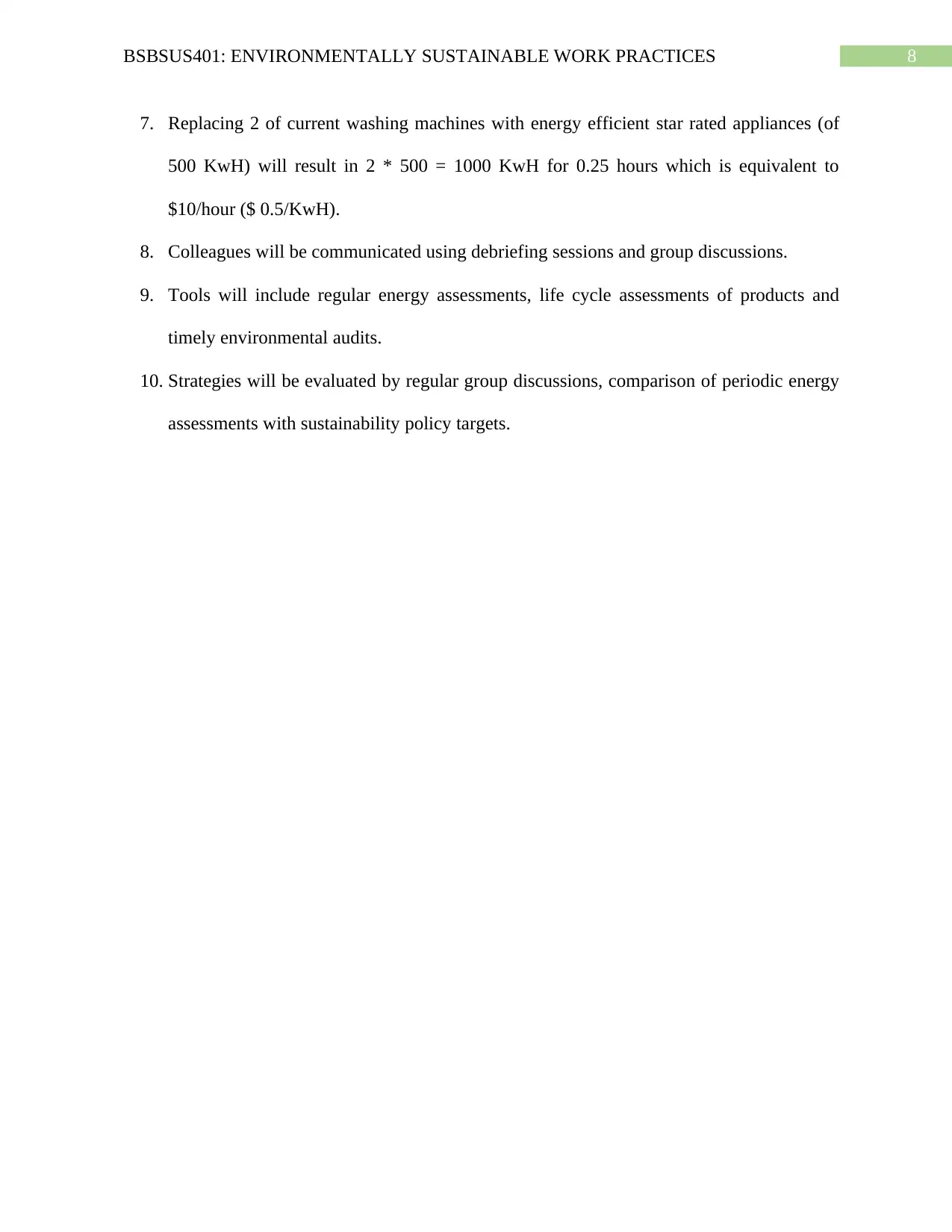
8BSBSUS401: ENVIRONMENTALLY SUSTAINABLE WORK PRACTICES
7. Replacing 2 of current washing machines with energy efficient star rated appliances (of
500 KwH) will result in 2 * 500 = 1000 KwH for 0.25 hours which is equivalent to
$10/hour ($ 0.5/KwH).
8. Colleagues will be communicated using debriefing sessions and group discussions.
9. Tools will include regular energy assessments, life cycle assessments of products and
timely environmental audits.
10. Strategies will be evaluated by regular group discussions, comparison of periodic energy
assessments with sustainability policy targets.
7. Replacing 2 of current washing machines with energy efficient star rated appliances (of
500 KwH) will result in 2 * 500 = 1000 KwH for 0.25 hours which is equivalent to
$10/hour ($ 0.5/KwH).
8. Colleagues will be communicated using debriefing sessions and group discussions.
9. Tools will include regular energy assessments, life cycle assessments of products and
timely environmental audits.
10. Strategies will be evaluated by regular group discussions, comparison of periodic energy
assessments with sustainability policy targets.
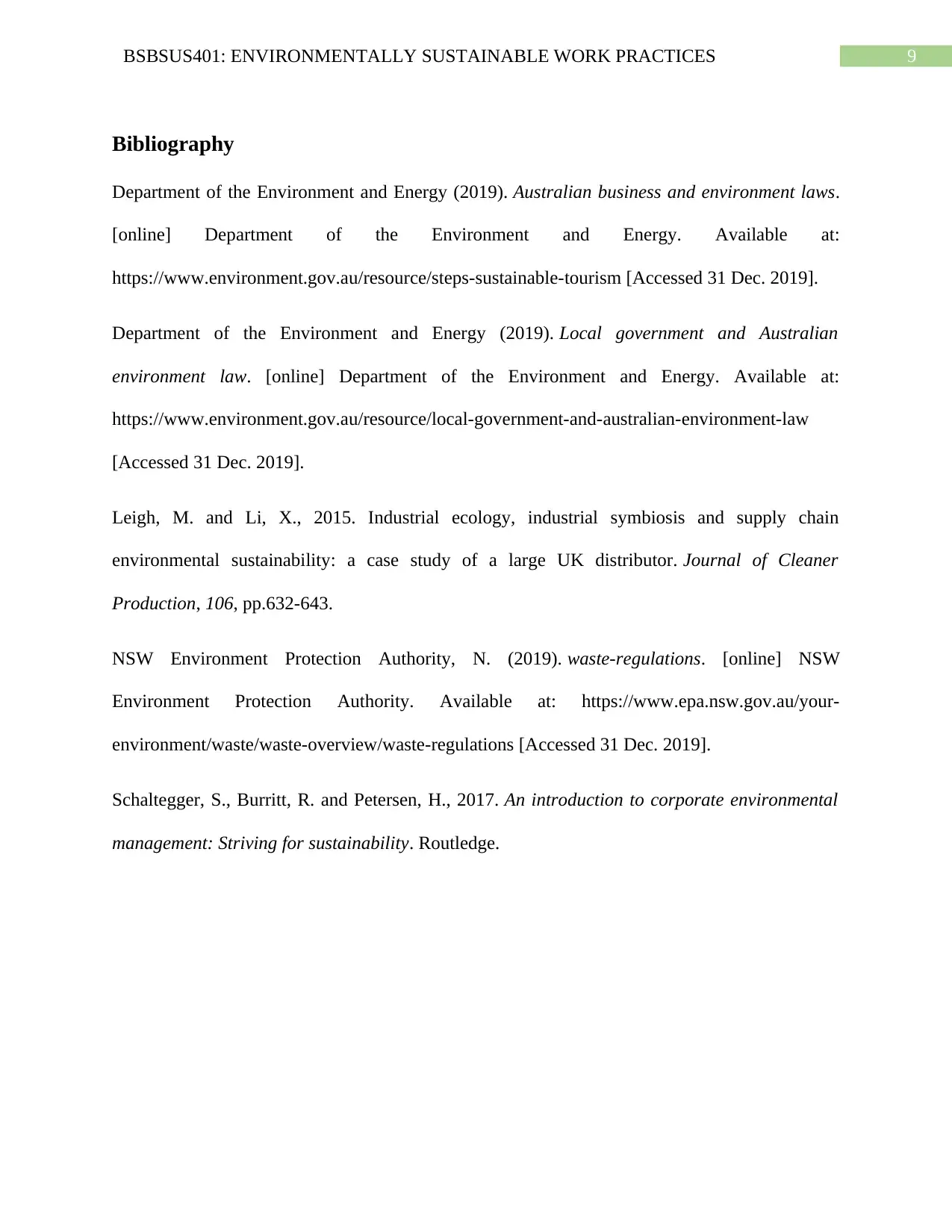
9BSBSUS401: ENVIRONMENTALLY SUSTAINABLE WORK PRACTICES
Bibliography
Department of the Environment and Energy (2019). Australian business and environment laws.
[online] Department of the Environment and Energy. Available at:
https://www.environment.gov.au/resource/steps-sustainable-tourism [Accessed 31 Dec. 2019].
Department of the Environment and Energy (2019). Local government and Australian
environment law. [online] Department of the Environment and Energy. Available at:
https://www.environment.gov.au/resource/local-government-and-australian-environment-law
[Accessed 31 Dec. 2019].
Leigh, M. and Li, X., 2015. Industrial ecology, industrial symbiosis and supply chain
environmental sustainability: a case study of a large UK distributor. Journal of Cleaner
Production, 106, pp.632-643.
NSW Environment Protection Authority, N. (2019). waste-regulations. [online] NSW
Environment Protection Authority. Available at: https://www.epa.nsw.gov.au/your-
environment/waste/waste-overview/waste-regulations [Accessed 31 Dec. 2019].
Schaltegger, S., Burritt, R. and Petersen, H., 2017. An introduction to corporate environmental
management: Striving for sustainability. Routledge.
Bibliography
Department of the Environment and Energy (2019). Australian business and environment laws.
[online] Department of the Environment and Energy. Available at:
https://www.environment.gov.au/resource/steps-sustainable-tourism [Accessed 31 Dec. 2019].
Department of the Environment and Energy (2019). Local government and Australian
environment law. [online] Department of the Environment and Energy. Available at:
https://www.environment.gov.au/resource/local-government-and-australian-environment-law
[Accessed 31 Dec. 2019].
Leigh, M. and Li, X., 2015. Industrial ecology, industrial symbiosis and supply chain
environmental sustainability: a case study of a large UK distributor. Journal of Cleaner
Production, 106, pp.632-643.
NSW Environment Protection Authority, N. (2019). waste-regulations. [online] NSW
Environment Protection Authority. Available at: https://www.epa.nsw.gov.au/your-
environment/waste/waste-overview/waste-regulations [Accessed 31 Dec. 2019].
Schaltegger, S., Burritt, R. and Petersen, H., 2017. An introduction to corporate environmental
management: Striving for sustainability. Routledge.
1 out of 10
Your All-in-One AI-Powered Toolkit for Academic Success.
+13062052269
info@desklib.com
Available 24*7 on WhatsApp / Email
![[object Object]](/_next/static/media/star-bottom.7253800d.svg)
Unlock your academic potential
© 2024 | Zucol Services PVT LTD | All rights reserved.

